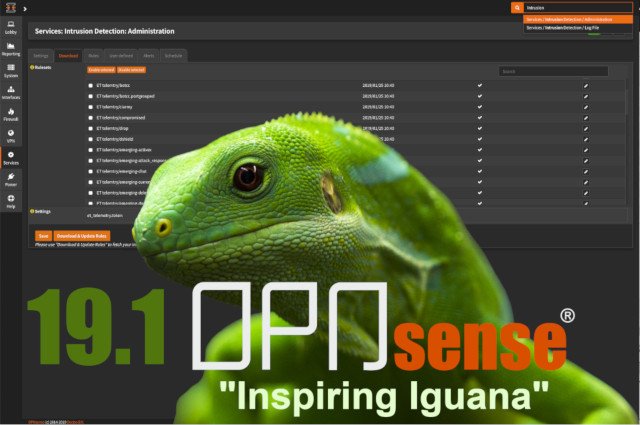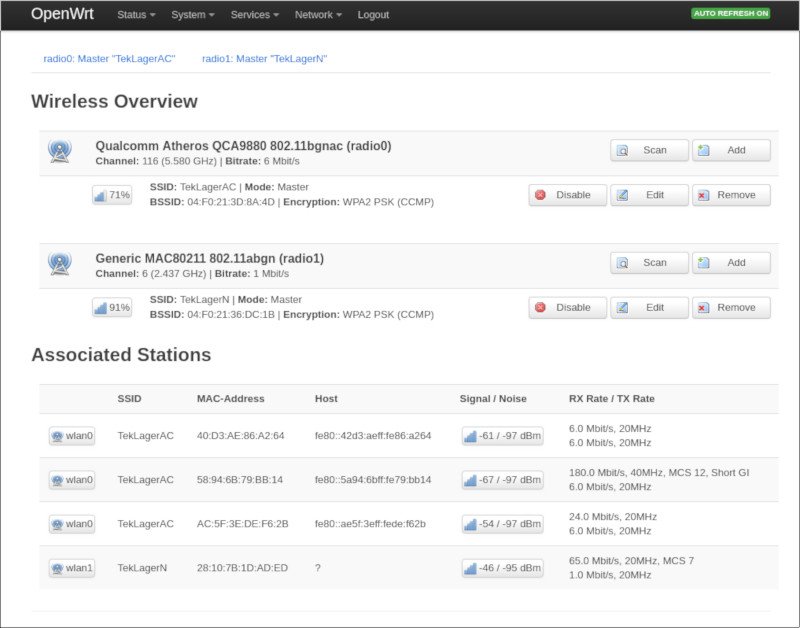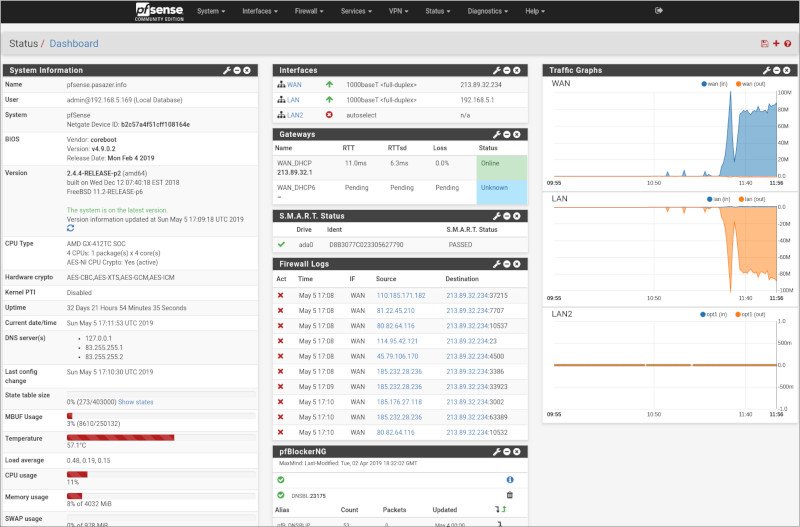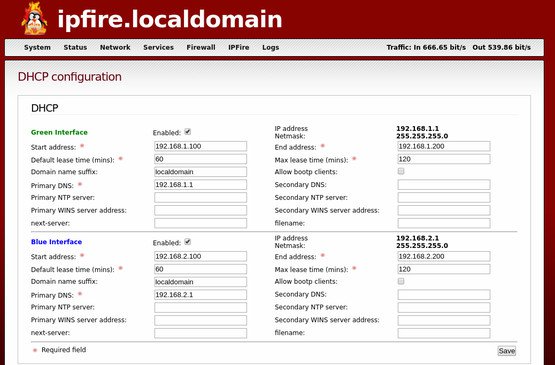Best free Linux router and firewall distributions of 2023
This article was last updated on December 30, 2022.
There are countless Free and Open Source Linux/BSD distributions to choose from for your router. However, there are many outdated recommendations on the internet, so it's not an easy choice. Therefore, we have decided to create a definitive firewall comparison for 2023.
Wikipedia has a list of router and firewall distributions, but the list is not useful because it's inaccurate (as of January 2023), and it doesn't really compare these systems in a way that helps making the choice without trying all of them one by one. It also lists many outdated and irrelevant systems that should be avoided in 2023.
If you are looking to get the most out of your hardware appliance or are building a new firewall, we have done the research for you.

Why is our router distro comparison better than others?
We have been selling hardware for building Open Source firewalls and routers for many years. Over the last year, we have installed and configured most, if not all, distributions out there. We install and configure pfSense, OPNSense, OpenWRT, Vyos, IPFire, and other systems daily, so we have a good idea of which Operating Systems work better than others. In addition, we don't make any money from any software vendors, which makes this recommendation relatively objective.
We hear customer feedback daily; if there are performance issues or problems with updates, we hear about it.
Top 10 Open Source Firewall Software to avoid - what you should NOT use.
Other comparisons recommend Operating Systems that are long dead or no longer relevant. This is most likely because these "Top 10 Open Source Linux Firewall Software" lists are copied from year to year by non-technical users without doing the actual work of comparing them.
Some Operating Systems have been superseded or stopped being maintained and become irrelevant. You want to avoid such systems because of security reasons - these distros are outdated and have insecure Linux/BSD kernels, potentially exposing you to security exploits.
1. IPCop - avoid at all costs.
Once a popular operating system, included in all "top 10" lists such as this one. You should avoid using it. The last release was in 2015, and the system is ancient by today's standards. The official website is dead, but the source code is still out there. Don't use it.
2. Smoothwall - long dead.
Smoothwall got a good reputation in the early days when it was competing with IPCop. It went silent in 2014. Smoothwall OS has been abandoned and is no longer relevant or secure. You should avoid it. The website is still up and running but hasn't been updated in many years.
3. DD-WRT - no longer competitive.
This is a controversial recommendation because many users still feel that DD-WRT is good. It certainly was back in the day. Today DD-WRT is still functional and works, but it's not great or innovative. It's mostly unchanged since 2014 and fell far behind other open-source competitors. Today there are many good alternatives, such as OpenWRT.
4. M0n0wall - retired.
M0n0wall is the godfather of the most successful operating systems we have today. It's been one of the most innovative projects of its day, but it's now retired. The system hasn't received any updates since early 2014 and is officially abandoned.
Manuel Kasper, the author of M0n0wall, recommends OPNSense as its successor.
5. Tomato - not for new routers.
Tomato is cool, and we love it, but it's minimal firmware designed for flashing off-the-shelf routers such as D-Link and Asus. The system is still relevant if you want to resurrect your old hardware and make it functional again, but if you are building a new router, you probably don't want to use tomato on it. We are building powerful routers from scratch, so we generally don't use this system (we still love it).
6. Zeroshell - abandoned.
Although Zeroshell never reached the point of being good enough to be recommended, we had high hopes for it in 2019 when we started maintaining this list of recommendations because it was developed from scratch rather than based on another system and had some innovative features. Unfortunately, the system got officially abandoned in September 2021. No longer maintained and secure.
Not recommended because they are not user friendly
These systems are relevant and receive updates, but we still don't recommend them, at least to less technical users.
We don't recommend the below systems because they require relatively high expertise to perform simple tasks. These days, SOHO routers (Small Office / Home Office) should be easy to set up and have an Intuitive Web Interface to manage. Updating your router should not require hours of work on the command line. For these reasons, we don't recommend the following systems:
7. VyOS - no Web interface.
We actually like VyOS. It's a good, innovative system that is actively developed and receives regular updates. So why don't we recommend it, then?
VyOS must be managed from the command line, and it requires a high level of expertise to maintain and use. If you are a Linux expert, have some time on your hands, and love the command line interface, you can give it a shot - some of our customers use it successfully. However, it's not a good choice if you are a home user who just wants to get things done.
There are two release variants of the system. The "stable" release and the "rolling" release. Most users likely want to use the stable release; however, this release is only free if you compile it from the source code yourself. This hurdle discourages many users. The rolling release is free but not guaranteed to be stable - and we can attest to this as several times we hit a bug when installing it. The rolling release also isn't covered by the official documentation.
8. OpenBSD and FreeBSD - use only if you have 10+ years of the command line experience.
OpenBSD and FreeBSD are actively developed and are very capable, but these systems require a high level of understanding of operating system internals and low-level networking to be used as routers.
We routinely install both systems for customers that are experts, such as network administrators or software developers. If you don't want to mess with system internals and spend hours reading manuals, this is not a system for you. It does not provide any Web UI or GUI tools for configuration. It's a barebones terminal-based system.
9. Debian and Ubuntu - don't use general-purpose OS for your router.
These systems are not intended for routers. They are general-purpose operating systems and should not really be used as routers. Similar to OpenBSD and VyOS, you will have to configure everything by hand without a Web Interface. It's easy to make a mistake and leave a hole that exposes internal systems to attackers.
Not recommended because they are not really free
There are also a few systems we don't recommend because they are not truly free or open source.
10. Untangle - is it really free if OS asks you to upgrade to a paid version?
Untangle NG Firewall is truly great software with many happy users. However, we don't recommend it because the free version is very limited, and the operating system constantly incentivizes the users to upgrade to a paid subscription to unlock the cool functionality. The cheapest license is $50 USD/year.
11. Sophos - small fish in an enterprise pond.
Sophos "XG Firewall" distribution has a very friendly user interface and is free for home use. However, we generally don't recommend it because it's not a system that Sophos itself promotes. Sophos' website seems to make it purposefully hard to find, and the community is very small. Sophos, in general, is an enterprise software company with one community product. It's not an Open Source system - it's a free product from an enterprise.
12. Endian - you really have to pay to use it fully.
Endian is actually pretty cool and has a free version. We don't recommend it because features like WiFi are available only in paid subscriptions. Similar to Untangle, it's good software, but you have to pay for it - this disqualifies it from our consideration.
Best Linux/BSD Router distribution in 2023 (4 recommendations)
To choose the best Operating System for routers, we have set a few basic guidelines. All systems not compatible with these guidelines have been rejected.
Basic requirements for choosing Firewall Operating System
- The system must be actively maintained and regularly receive security patches.
- The system must be fully Free and Open Source
- The system must have a Web interface or GUI. Command line operating systems are disqualified.
- The system must be performant and work well for a typical user.
These basic requirements are reducing the list of recommendations to 4 systems. pfSense, OpenWRT, OPNSense, and IPFire.
1. OPNsense - our top recommendation.
OPNsense makes the top of the list in 2023 because, for the last four years of maintaining this list, it has proved to be one of the most quickly developing operating systems on the market. It's an easy to use, mature system with a slick UI. OPNSense includes most, if not all, features found in expensive enterprise commercial firewalls. It has the quality of a commercial product while being completely free and open source. The community forum is particularly friendly and helpful.
OPNsense is often the first to introduce new features. For example, WireGuard support first appeared in OPNsense. The other systems were much slower to include it.
OPNSense offers weekly security updates, which makes it one of the most secure solutions on the market. In addition, each year, there are two major releases of the operating system that bring many new features.
It's a stable solution that we often recommend to users who are unsure which operating system to choose.

Advantages
- Best Web Interface / GUI
- Most frequently updated
- Support for features not found elsewhere
Disadvantages
- OPNSense is BSD-based, which is a disadvantage in some cases;
- WiFi support is very limited. If you plan on using WiFi on your router, get a Linux-based operating system.
- BSD also limits the maximum throughput per connection. A single connection on OPNSense will not utilize the full capacity of a multi-core CPU. (this is often not important because multiple connections can be established
2. OpenWRT - a proven veteran
OpenWRT is a Linux-based operating system for routers, recognized almost by everyone. It's been first released in 2004, over 15 years ago, and is still actively developed and maintained.
Unlike IPFire, OpenWRT has a large number of optional packages in its repository. As a result, you can configure this OS in countless different ways. Most importantly, OpenWRT has drivers for all hardware supported by Linux. This means that almost all Wireless hardware is supported, making it the most versatile OS for creating Access Points.
OpenWRT has the lowest hardware requirements of all operating systems we have reviewed. It achieves much higher throughput on low-power devices than pfSense and OPNsense.

Advantages
- It has the best WiFi support. It supports all the latest wireless standards and has an excellent Web Interface for quickly configuring and managing WiFi access points.
- Utilized all CPU cores for routing and achieves the best routing performance
- There are about 3500 optional software packages available for installation.
- It boots in about 7 seconds. Much faster than other distributions.
Disadvantages
- Its Web interface is lightweight, but some parts are not very intuitive. The UI for the firewall is not as user-friendly as on other systems.
- The installation process requires more steps than other systems.
- The upgrade procedure often requires a complete reinstallation of the system.
3. pfSense - most popular
pfSense is one of the most popular operating systems today. It's a BSD-based system, similar to OPNSense, but with a longer history. pfSense started in 2004, and since then, it has grown to be the most well-known open-source platform in the industry. Although it gradually loses users to OPNsense, it's still an excellent system for new users because it has the most extensive documentation and the biggest community. In addition, there are thousands of tutorials, forums, blogs, and youtube videos all over the internet that will be helpful if you get stuck on something.

Advantages
- Stable and reliable
- Biggest community
- A large number of tutorials/documentation on the web
Disadvantages
Similar to OPNSense, pfSense is based on BSD so:
- WiFi support is very limited. If you plan on using WiFi on your router, get a Linux-based operating system.
- BSD also limits the maximum throughput per connection. A single connection on OPNSense will not utilize the full capacity of multi-core CPU. (this is often not important unless you have a gigabit internet connection)
- Infrequent releases in comparison to other systems. Roughly 1 major release every 12-18 months.
4. IPFire - contender
IPFire is a Linux-based distribution intended for Firewalls and Routers.
IPfire is a continuation of IPCop (mentioned above) but has been rewritten from scratch. The system is regularly updated and maintained, but it doesn't have many features found in pfSense or OPNSense. It passes all our requirements but barely makes this list of recommendations because it has no advantages over the other three systems listed. We recommend trying it only if the other three systems don't satisfy your needs.

Advantages
- It's Linux-based, so it supports WiFi (although the web interface is confusing and limited)
- It utilized all CPU cores, making it very fast on multi-core CPUs
- It's regularly updated and maintained.
Disadvantages
- The Web interface is probably the worst of the four recommended systems. Not very modern and not intuitive.
- Harder to configure WiFi in comparison to OpenWRT. Only 1 WiFi AP is supported. Some features require the use of the command line.
- Very few software packages are available for installation.
- Not all functions can be configured via the web interface. Some require tinkering with a command line.
- No advantages over OpenWRT
Final verdict
In short, if you plan to use WiFi in your router, choose OpenWRT. It has the absolute best support for wireless of all systems we have tested.
If you don't need WiFi support or are planning to use separate Access Points, we recommend OPNSense or pfSense.